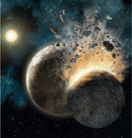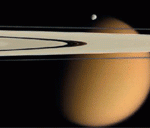 Our solar system may have plenty of cosmic cousins. Scientists studying archived data have spotted an adolescent sunlike star with a dusty belt that shows evidence of the creation and violent destruction of baby planets. “There is no doubt that they are detecting the dusty debris of rocky [Earth-like] planet formation,” says Scott Kenyon of the Harvard-Smithsonian Center for Astrophysics. A report of the find, by a team headed by Joseph Rhee of the University of California, Los Angeles, is in press at The Astrophysical Journal.
Our solar system may have plenty of cosmic cousins. Scientists studying archived data have spotted an adolescent sunlike star with a dusty belt that shows evidence of the creation and violent destruction of baby planets. “There is no doubt that they are detecting the dusty debris of rocky [Earth-like] planet formation,” says Scott Kenyon of the Harvard-Smithsonian Center for Astrophysics. A report of the find, by a team headed by Joseph Rhee of the University of California, Los Angeles, is in press at The Astrophysical Journal.
Until 2005, astronomers had observed only very young possible planet-forming systems. Then data from the retired Infrared Astronomy Satellite revealed a more mature system, bolstering predictions that collisions continue well after planets form. The latest observation, from a star called HD 23514 in the Pleiades cluster, should “help generalize the model of planetary formation,” says David Trilling of the University of Arizona in Tucson. Combined, the two discoveries allowed the team to estimate that about 1 in 1000 stellar systems share our system’s turbulent past–and could share its present architecture.
First published in Science Magazine as a Random Sample: [html] [pdf].
